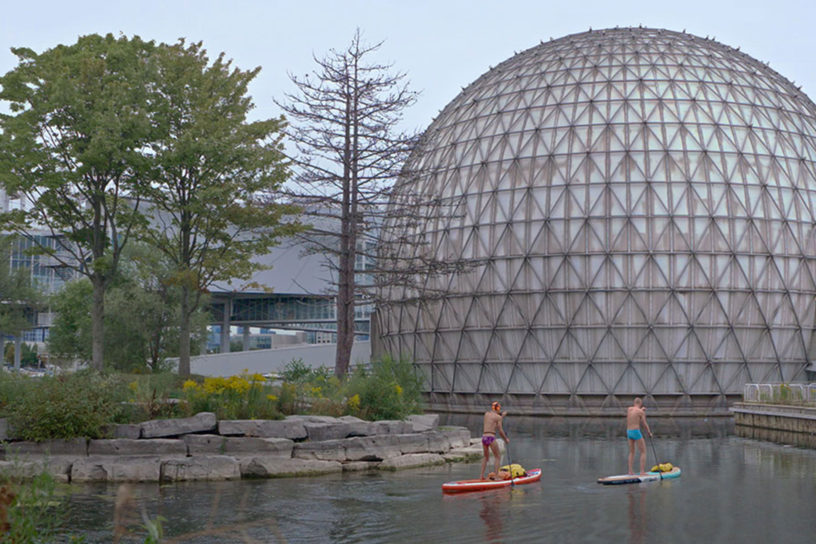By Saif-Ullah Khan
When people think of Ontario Place—a park on the city’s west end—their first thought usually isn’t an eccentric university professor playing a strange water instrument in the middle of the lake. Thanks to Your Tomorrow, it might be now.
For the filmmakers, the documentary offers the chance for a conversation about spaces like Ontario Place and what the future holds for them. The film archives joy, simplicity and warmth within a situation clouded by complicated and often dense politics. It was acquired by Blue Ice Docs and will be streamable on TVO by early 2025.
Your Tomorrow takes the approach of an observational documentary—capturing realistic, everyday moments that build up for the entirety of the film without any interruption from the crew. Watching the documentary is like people-watching at the park. Viewers are invited into intimate moments with the area’s community as each character enjoys the park and reacts to the growing closures of its already limited space.
Many residents from the Greater Toronto Area likely have some sort of childhood memory connected to Ontario Place. Located along the Toronto waterfront, the once bustling public space was home to rides, attractions, a children’s village, various concert venues, public programming and the world’s first permanent IMAX movie theatre. Built with a unique architectural design and surrounded by landscaped green space, the park was developed on two man-made islands to showcase Ontario’s culture and identity in the early 1970s.
Ontario Place closed in 2012 but later reopened as a public park without most of its old attractions. After a two-year bidding process in 2019, the provincial government shared redevelopment plans that included West Island being converted into a private spa.
The City of Toronto documents revealed that the public asked the provincial government to preserve and create more green space at Ontario Place instead of redeveloping the land for commercial use. Hundreds of community members attended consultation meetings where the “majority of attendees did not support the redevelopment plans for the West Island,” according to reports from the city.
For Toronto Metropolitan University (TMU) documentary media studies graduate Ali Weinstein, Ontario Place wasn’t something she had thought about much since she stopped going as a child. Her parents had gone to the park since its opening in 1971 but no one paid much attention when the provincial government shared redevelopment plans 50 years later.
When the COVID-19 pandemic hit, Weinstein found herself back at Ontario Place. The park offered solace at a time when most public spaces remained closed and served as a gathering point for her friend group during the pandemic. During this time, Weinstein said she felt a desire to document the space before it would be changed forever.
“There is still a bit of a question of ‘what is tomorrow’ at Ontario Place? What is it that we want for ourselves?”
TMU image arts film studies graduate Andrew Moir and documentary media studies graduate Caitlin Durlak joined the project as a cinematographer and editor respectively.
Weinstein and Durlak completed their masters in fine arts at TMU together in 2012 and developed a connection that has lasted over 10 years of working together. The filmmakers attribute the opportunities they have today to relationships formed in university.
“Let Ontario Place be a reflection of [community]. Ali and I met in film school and when we graduated a year later, we started working on a film together. We still show our work to our peers,” said Durlak. “People you meet in school can be these larger stepping stones to something that you can’t understand at that given moment.”
Moir said working on student projects taught him the importance of using less to create more, which came in handy during the early stages of working on the documentary.
“Learning to work within your limitations is so important,” said Moir. “You really have to learn how to be resourceful and work within your means—that often makes the film better.”
The audience can share the disappointment of a dog whose usual walking route becomes blocked by construction fencing. They could share in the wonder of the beach crowd watching University of Toronto professor Steve Mann play a mysterious water instrument by the shore. Viewers are introduced to a Japanese Canadian temple bell that was gifted by the community in commemoration of the centennial of Japanese settlement in Canada. Some visitors ring it to their amusement, others look inside and some just admire its beauty. The bell is last seen being wrapped up and removed by a group of construction workers as the redevelopment moves ahead.
The documentary structures itself around the young employees working at the park. The film uses them as an introduction to the story, checking in with the student workers throughout the film and keeping them as a central part of the narrative.
According to Weinstein, these employees offered an important viewpoint because they were not tied to the park by the same nostalgia as most of the other subjects. The student workers offered a refreshing take just by being bored at work, getting confused by Ontario Place activists or teasing their boss.
“We would always talk about how we wished we worked at Ontario Place when we were younger,” said Weinstein.
While the job may seem relatively normal to some young people, the filmmakers believe the students will look back on their role within Ontario Place with wonder, an element the team hadn’t anticipated.
“One of the themes that comes through in the film is innocence, play and child-like wonder,” Weinstein said. “I saw it in a lot of the people we filmed with and it’s exactly how I felt whenever I was there with my friends prior to filming.”
The film also shares moments with a retired couple who converse in Mandarin while sitting in front of the lake. Unlike their younger counterparts, the couple feel a deeper connection to Ontario Place and speak with wisdom behind their words.
“They’re naturally very poetic in the way that they spoke to each other,” said Durlak. “Probably because they have such a long relationship and understanding.”
The filmmakers shared that the couple’s daughter—who helped confirm that the film’s translations were accurate—was grateful that the documentary captured them “exactly as they are.”
A slight catharsis surrounds the documentary, leaving space for the audience to reflect on their own connection to Ontario Place. In a brochure from 1969, Ontario Place is described as a mirror to show your work, your creativity, your tomorrow.
“I just felt like that was really apt. This was a forward-looking, futuristic vision for the public. Fifty years later, we’re documenting ‘this today’ and the change that’s happening,” said Weinstein. “There is still a bit of a question of ‘what is tomorrow’ at Ontario Place? What is it that we want for ourselves?”












Leave a Reply